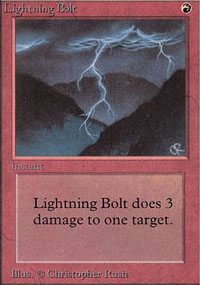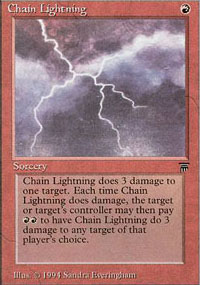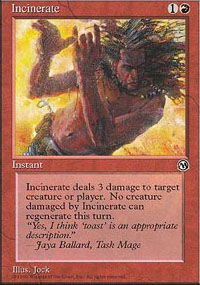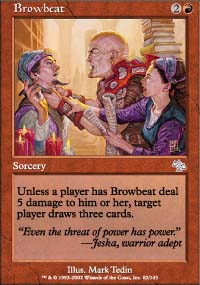
Sherman, set the Wayback Machine for 1993. Grunge has swept the music scene, giving hair metal a good curb-stomping in the process. Your humble scrivener is in college, majoring in Billiards, Drinking, and Video Games. The Alpha release of Magic has five “boon” spells in it – spells which provided three of something for a mere one-mana investment. While Ancestral Recall turned out to be the superstar of the group and Dark Ritual would prove to be the problem child, Lightning Bolt is the card we’re here to discuss.
The classic Bolt still sees play today, in Legacy’s Burn decks. It’s been reprinted in the form of a sexy judge promo. Lightning Bolt has been imitated often over the years, most notably with Chain Lightning and Incinerate, and was eventually replaced because getting three damage for one mana was deemed too good by the powers that be. Shock, first glimpsed in Stronghold, became the new benchmark for burn when it was reprinted in 6th Edition.
 ->
->  ->
-> 
Call me old school, but I still prefer the classic Lightning Bolt. Back in the day, the ability to blast a first-turn 2/3 Kird Ape was huge. Kird Ape is back in 9th Edition after a long absence from Standard, but if he’s powered up to 2/3 (harder to do than it was back then, but the upcoming R/G shockland will make that easier), Shock isn’t going to do much to him. Sure, you can use Shock and another spell, or Shock and a guy, to take down the Ape, but then you’re giving 2-for-1 card advantage to your opponent.
After the printing of Ravnica, I again want to use Lightning Bolt as the metric for good burn. Obviously, there are no spells made today which immediately remind anyone of Lightning Bolt. (And, no, Lava Spike certainly doesn’t count, but we’ll get to that in a bit. Patience, grasshopper.) However, it is again possible to get 3 damage from a single card and do it pretty cheaply. We’ve had a few of those ways in Standard for a while now, but Ravnica has given us more. Getting 3 damage from one card is the metric we’re going to use in this article.
So why is Bolt a better metric than Shock? Getting in an extra damage to your opponent can obviously be beneficial – how many times have you lost games when your opponent ended up at 1 or 2 life? Having a Bolt instead of a Shock could have been the difference. Also, consider some of the defining creatures in the post-Ravnica Standard world:

Circu, Dimir Lobotomist: Only Bolt kills this fellow.
Watchwolf: Watch Shock not do much.
Kird Ape: Shock is suboptimal.
Birds of Paradise and other mana creatures for G: If there were a spell called Sneeze, they would die to it.
Paladin en-Vec: Um . . .
(Brief aside: I think Paladin en-Vec will be one of the most important creatures in the new Standard. Not only is it immune to all the burn that’s out there, but it’s also impervious to Putrefy, which will be a format-defining spell. This was a very good reprint. As a 2/2 for 3, the Paladin isn’t the ideal aggressive creature, but his abilities put him over the top. Look for Paladin en-Vec to get some play in Extended, also, for similar reasons.)
There are creatures which will die to both, but against some very important men, Shock just isn’t enough. So let’s look at the Bolt effects we have available to us in Standard now and see just how good they really are.
Lava Spike: The lack of versatility makes this card mediocre. It can only go to the dome, meaning problem creatures are completely free from its reach. The best thing about Lava Spike, of course, is that it’s Arcane, allowing you to splice things like Glacial Ray onto it. That gives you a saucy 5 damage for 1 card (since the Ray never leaves your hand), even if it does cost .
Lightning Helix: Now we’re cooking with gas. Healing Salve, the red-headed stepchild of the original “boons,” here gets stapled onto Lightning Bolt to form the defining burn spell of the new Standard. With enough nonbasic lands to make its two-colored mana cost easy to meet, Lightning Helix will be a staple for the next two years. It kills all the relevant 3-toughness creatures in the format and can go a long way toward finishing off a struggling opponent. Get a set of these if you haven’t already. (If you’re like me, though, you have two 5-Color decks to support, meaning you need three sets.
Volcanic Hammer: The fact that it’s a sorcery is a knock against it, but the Hammer does give you a Bolt effect. It also kills all the relevant 3-toughness creatures in the new format, with the added ability of being able to dome your opponent.

It's better than it might look.
Yamabushi’s Flame: If there was a drop in quality from Lightning Helix to Volcanic Hammer, then we’re in free fall now. While Yamabushi’s Flame is a Bolt, it’s also a Bolt at the steep price of . We know we can’t pay just for a Bolt anymore, so paying 2 mana is acceptable. Having to pay 3 is not nearly so desirable. This does, however, kill 3-toughness creatures and prevent them from coming back to menace you again, while also going to the dome. It’s a respectable spell that could see some play, but it’s far from a staple.
So, with all these playable Bolts, they have to fit into a good mono-Red deck, right? Well, not exactly. Playing mono-Red removes Lightning Helix from consideration, and that card is too good to ride the pine. Playing White along with Red lets you take advantage of all the good Bolts. There are two ways to go with this: a White Weenie deck that essentially splashes for burn and a little creature support, or a RDW-style burn-centric deck. Let’s take a look at lists for each:
This is not meant to be a finalized list for States, but rather a jumping-off point that illustrates where the deck is and can go. Having a dozen fliers gets around the problem that Carven Caryatid presents for ground-based aggro decks. Isamaru is a good man, but he becomes a lot less good when a 2/5 plant thingy is staring him in the face. I’d rather have fliers who can go right over the Caryatid. It’s possible that more fliers could be correct, but 12 seems like a good number. The eight ground creatures are solid, and are immune to Putrefy. With 11 burn spells, odds are good that you’ll have enough to dome your opponent when the time comes. Even a deck like W/R control, which can sweep the board pretty easily, is vulnerable to you throwing down 7-10 damage in a single turn.
What about a deck based more on recent “Red Deck Wins” archetypes? We don’t have any recurring damage sources like Grim Lavamancer available, but there are still plenty of dorks and good burn spells to be had.
| Red (and White) Deck Wins 2K5Magic OnlineOCTGN2ApprenticeBuy These Cards | ||
|---|---|---|
|
4 Isamaru, Hound of Konda 4 Hearth Kami 4 Leonin Skyhunter 4 Hand of Honor 3 Skyknight Legionnaire | 4 Lava Spike 4 Lightning Helix 4 Volcanic Hammer 4 Yamabushi’s Flame 3 Char | 4 Sacred Foundry 4 Battlefield Forge 4 Mountain 10 Plains |
If it doesn’t look significantly different than the previous deck, you’ll just have to take my word for it that it is. The creature configuration is much different, emphasizing speed and the power-to-mana-cost ratio at the expense of evasion and utility. The spells are all Bolts, unlike the previous deck, which also included Umezawa’s Jitte and Glorious Anthem. This deck can very easily win by playing a “burn your face” gameplan after a few swings with its creatures. If you expect your States to be heavy on board-control decks like B/G and Gifts, this might be a better answer, since they’re ill-equipped to deal with a Bolt or two every turn.
Is it possible to build a mono-Red deck in Standard and still maximize your bolts? I don’t think it is, simply because you cut yourself off to Lightning Helix that way. It’s so easy to play a second color these days, and Lightning Helix is like a loose, tipsy woman at closing time: she’s just waiting for you to go pick her up, slugger. I’ll stop before continuing that simile* into things like sleeves and protection. Ahem.
Before we try looking at a mono-Red (or mostly-Red) deck, I want to consider if it’s possible to make a deck that’s entirely comprised of Bolts. Not just spells, either – I want creatures that get in there and hit for 3 damage, too. A while ago, Mike Flores postulated on The Philosophy of Fire, the goal of which is to trade your cards for your opponent's life, with the default damage unit being a Shock. I’m going to propose The Lightning Bolt Metric, where the goal of the deck is to make everything a Bolt, thus trading your cards for your opponent's life at a faster rate. Even if it’s not viable in Standard, older formats add more cards to the mix, and it could be good in those formats.
Remember, everything in your deck that isn’t a land has to be a Bolt: it has to be one Red card that does 3 (or more, if you can get it) damage. The goal is to kill your opponent by turn 7, though in reality, you should be able to accomplish it earlier than that. Depending on the format, you could goldfish as early as turn 4 or 5. Against an actual opponent playing threats and answers of his own, your kill will vary. Unless your foe is playing a hyper-aggressive deck, though, it’s usually safe for you to just throw burn at his head until he succumbs to it. Depending on the matchup, you might not be able to have a deck full of Bolts after sideboarding. You might find that Red Elemental Blast is necessary to keep the countermagic in check, or that Molten Rain is needed against a deck like Tooth and Nail.
The toughest thing to fit under the Lightning Bolt Metric is creatures. To qualify as a Bolt, a creature has to hit for 3 (or more, preferably). This takes away traditional Red weenies like Jackal Pup and Goblin Cadets – they’re fine for the Philosophy of Fire, but they don’t measure up to the Lightning Bolt Metric. Red doesn’t have a lot of heavy-hitting creatures, and the ones it does have are usually either very good or godawful. Ball Lightning is a fine choice. Ore Gorger? Not so much. The creature does need to be efficient, after all; you can’t be blinded by the fact that it has 3+ power.
I’m going to post a couple of lists for older formats. Again, these are not meant to be tuned lists you can take into a PTQ or GP and smash face with. (If you do, though, the credit is all mine. Mine, I say!) At this point, they’re just exercises in the theory of the Lightning Bolt Metric, to see how easily (or not easily) adaptable it is, and to see how good and consistent the final list looks.
| Bolt, Bolt, Bolt; Post-Rotation ExtendedMagic OnlineOCTGN2ApprenticeBuy These Cards | |
|---|---|
|
4 Viashino Sandstalker 4 Blistering Firecat 4 Genju of the Spires 4 Lava Spike 4 Lightning Helix 4 Volcanic Hammer 4 Chain of Plasma 4 Pulse of the Forge 2 Char 2 Hammer of Bogardan | 4 Sacred Foundry 4 Battlefield Forge 16 Mountains |
The problem with the creatures is that there’s nothing I really like besides the Firecat. Spark Elemental is a Bolt, but it’s strictly much worse than a Bolt if you draw it after the first couple of turns, so that’s out. Akki Avalanchers is a Bolt, so long as you get thru with it and sacrifice a land (you can do this if it’s blocked, but Bolts aren’t supposed to trade 2-for-1 in the opponent’s favor). Minotaur Explorer costs you a probable Bolt from your hand, so he’s inefficient. Even if he only costs you a land, you need lands to get the recurring Hammer of Bogardan engine going. Flametongue Kavu is more than a Bolt to a creature when he comes into play, and then he Bolts either another creature or your opponent from there. FTK may be the better choice for those reasons, though he is obviously worse in control-heavy metagames.
The spells are all at least Bolts. There is enough burn to clear a path for Genju of the Spires. A set of the Genjus may be too many, in fact – 3 might be the more ideal number – and if one Genju can go, then another Bolt can take its place. Chain of Plasma is a Bolt no one really thinks about, and it can damage you if your opponent keeps it going, but you should be ahead in the life total race, anyway. Pulse of the Forge is a card I’ve seen in several decks while browsing the Premiere Event replays available on Magic Online. (If you don’t have Magic Online, incidentally, it’s worth it for that feature alone, even if you never plan to do any digital card-flopping.) Hammer of Bogardan is a recursive damage source, obviously best in the control matchups. In more aggro-heavy metagames, a faster card could be substituted.
What about Legacy? There’s already a burn deck in that format, based around using a lot of Bolts. However, many of those lists play sissy creatures like Mogg Fanatic and Grim Lavamancer. The Fanatic will be a Shock at best, and Shock is just not good enough when you’re operating under the Lightning Bolt Metric. Grim Lavamancer is a Bolt only when he blocks and activates to kill a 3/3, and situational Bolts are not true Bolts. We will suffer no more of these pretenders to the throne.
| Disco Inferno, LegacyMagic OnlineOCTGN2ApprenticeBuy These Cards | |
|---|---|
|
4 Ball Lightning 4 Lightning Bolt 4 Chain Lightning 4 Lava Spike 4 Incinerate 4 Price of Progress 4 Chain of Plasma 4 Fireblast 3 Pulse of the Forge 3 Flamebreak 2 Fork | 20 Mountain |
Astute readers will note that I’m playing a conditional Bolt in Price of Progress. In Legacy, especially with the new Ravnica lands coming into the picture, I expect Price of Progress to hit opponents for at least 6 damage. Depending on the deck you’re playing, this could be even more. Of course, against the mirror, it’s a dead card. If you expect it to be dead more often than not, then you can play with something like Browbeat or Flame Rift.
Consider the turn progression and how much burn you can throw at your opponent, considering everything in this build is a Bolt:
Turn 1: Lightning Bolt (3 damage)
Turn 2: Incinerate (total of 6 damage)
Turn 3: Ball Lightning (12 damage)
Turn 4: Chain Lightning + Fireblast (19 damage)
I realize that 19 != 20. However, Price of Progress on turns 2 or 4 could have done more damage than either the Incinerate or the Chain Lightning. Also, considering the number of fetchlands running around in the format, it’s reasonable to presume that your opponent has done 1 damage to himself at some point during the first four turns. And while that may look like the proverbial “god draw,” keep in mind that, when everything in your deck is a Bolt, the pieces are interchangeable. Not counting Fork, the deck plays 38 spells which deal at least 3 damage (34 real ones, plus the potential for Price of Progress to be more than a Bolt). You can pile up a lot of damage in 4-5 turns that way.

"Hey, n00b! Be sure to vote for
Dr. Tom next month in the AOTM race!"
Is this better than the existing burn decks in the format? At the risk of sounding immodest, I think it wipes the floor with those decks, pie-faces the players, and smacks the players’ mothers on their backsides. (Hey, if you’re running the risk of immodesty, you mise well go all out.) It looks better to me because the burn suite is upgraded, but the only real way to tell is to throw this deck into a Legacy gauntlet and find out. Again, the lists I’m giving are theoretical exercises to see how valid the Lightning Bolt Metric can be. In this case, with the wealth of Bolts available in Legacy, I think we might really be onto something. While the principle is sound in the other formats, the card pools are shallower.
To sum up, here’s what you should be looking for if you want to build a deck with the Lightning Bolt Metric in mind.
1. All your nonland spells should be Bolts – that is, they should do 3 damage. More is fine. Formats like Standard and Block may make this impossible, especially with regard to creatures. However, maximizing your Bolts makes your clock shorter.
2. All your nonland spells should be reasonably costed. Don’t play Ember Shot just to get another Bolt. (In fact, don’t play Ember Shot at all, no matter the circumstances.)
3. Your goal is to kill your opponent as quickly as possible. This means your burn should go to the dome whenever possible. If you have to kill a creature, do it, but you shouldn’t have to very often.
4. Cards which amount to Shock are unacceptable. Cards which are conditional Bolts may be acceptable, depending on the format and environment (Gaze of Adamaro was often quite potent in Kamigawa Block, for example).
5. Try to maintain as much purity as you can after sideboarding.
Is the Lightning Bolt Metric a valid theory to build decks around? Only time will tell. I hope you’ll consider using it as a yardstick in formats where it’s most relevant and tell us all just how good it is. I also hope this was an interesting theoretical exercise. Thanks for heading down this road with me.
-Tom Fowler
* Yes, it’s a simile** and not a metaphor. Similes are distinguished by the use of “like” or “as” to make the comparison, and I definitely used “like.” It kind of annoys me when people lump all comparisons under the “metaphor” umbrella. Show the similes some love.
** And yes, that’s “simile” and not “smilie.” There is life outside of message boards, you know.***
*** This statement has not been independently verified.
Comments